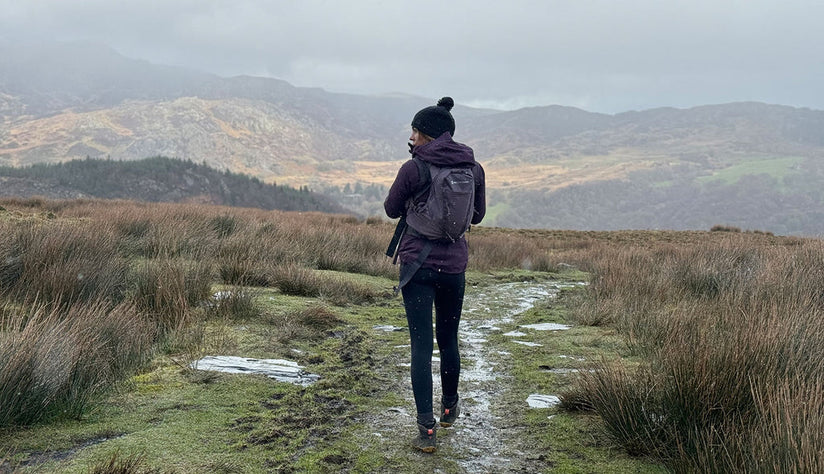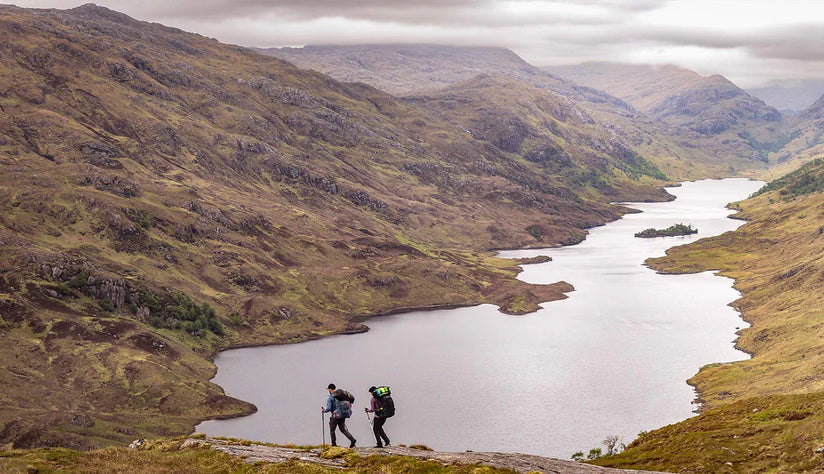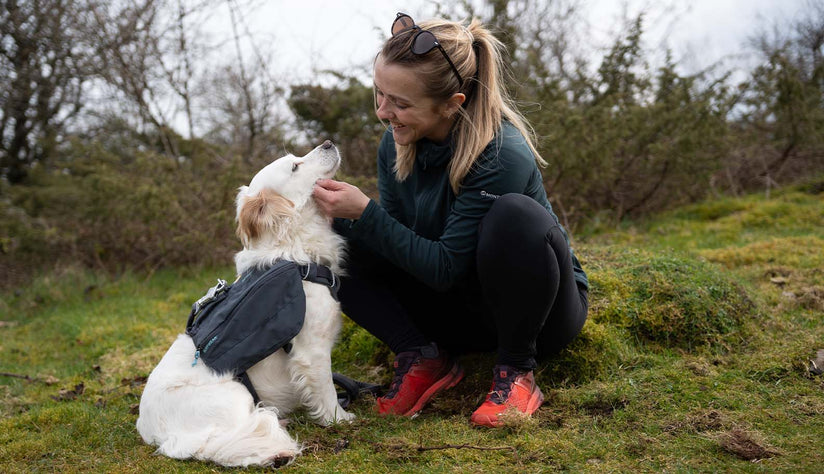Photo: Ben Ditto
Having successfully completed the first-ever ascent of the Mirror Wall’s West Face in 2015, celebrated climber Leo Houlding described the cliff as "an Arctic El Cap". The wall’s huge size and unrelenting steepness certainly resemble Yosemite’s iconic rock formation, but its remote location in Arctic Greenland is what really sets this challenge apart.
Fast forward a few years, and the seeds were sown for #TeamMontane climbing athlete Franco Cookson to join a new expedition to the region. The mission would not only include a never-before-completed climb of the Mirror Wall, but a unique journey by sea to Greenland. We catch up with Franco to find out how it went.

Why did you want to take on this big wall challenge?
The climbing objective of the trip was to try and climb the centre of Greenland’s Mirror Wall. This massive piece of granite is located in a remote part of east Greenland, 71 degrees north, and is around 1200m tall. A few other climbers have explored this valley, including Leo Holding, but no one has yet managed to climb this central part of the wall. When climbers try and climb new routes on a big wall like this, they usually use photos or binoculars and try and find little black lines. These normally mean there are crack systems, that provide holds, but even more crucially, protection. What is striking about the centre of the Mirror Wall is that there are none of these systems until about two-thirds of the way up.
It was perhaps madness to try an objective that was so obviously likely to be hard and poorly protected, but I think the whole team wanted to push the envelope on what is possible (and normal!) on a trip as remote as this one. It was a real honour to be invited by Sean and Nico, as they're some of the most accomplished expedition big wallers ever, and it was evident that there was an appetite to build on their decades of experience and try something truly 'next-level'. What really excited me about the face was the potential for hard free climbing. In recent years I've started to massively focus on vertical and slabby climbing and it seemed like a dream destination to climb some very hard pitches, in the kind of place where that doesn't usually happen.
For me the trip was so much more than just the climbing! As far as we know, no one had ever sailed to this valley in Greenland to climb. To give you some idea of how ridiculous a challenge it was... To reach what was for us advanced base camp with all of our equipment took us over 50 days from Scotland. This is the point that other expeditions have been dropped off by helicopter, which for us was around 20 miles from the boat, covering the worst valley terrain you could imagine. 
I knew that there would be a huge challenge to get there. I had also never sailed before and found this aspect of the trip full-on. We had fairly good weather, but we still had some big seas, some heavy rain, lots of swells, and a lot of extremely cold weather. I was surprised by how cold it was at sea. You could be in shorts and a t-shirt on land and then go five miles offshore, hit by a cool wind and you'd want to be fully wrapped up. The seas of Iceland are also very cold when compared to Scotland.
East Greenland is next level, as the wind whistles off the ice cap. It was really noticeable how much things warmed up on the way back, as we approached the north shore of Iceland. With the weather being largely dry, I managed to get away without waterproofs a lot of the time, living in the Montane Respond Trousers, which kept the wind and cold out and stayed warm, even in the damp conditions of the boat.
When we did have rain, it rained a lot. And even when it wasn't actively raining, there would be so much wind, or we would be sailing so hard on the wind, sea spray (or full on waves) would be flying over the cockpit (and one time into my face as I slept below...). In these conditions I found the Duality Lite Waterproof Jacket my go-to, as I needed something I knew would keep me dry, but also as much warmth as I could get.

Why was sailing there an important part of the experience?
I started my climbing hearing tales of Sean and Nico developing big walls by boat, with the help of the sailor Bob Shepton. I think it was something that really captured the imagination of a lot of people my age, so it was an opportunity that I couldn't say no to. I knew it would be hard - I suspected it would be really hard. There was the cognitive challenge of learning a new skill in sailing. Then there was the physical challenge of tolerating the cold (we had no heater on the boat for example), the sleep deprivation, perhaps the lack of food, and then the massive approach to the cliff. I suppose I wanted to see how they operated, now at the top of their game, and to see if I could keep up.
I've also always had a draw to the sea. I went to school in Whitby, so the sea has always been a massive part of my life. Even though I've never sailed, I've always loved boats - the aesthetics of them, the romance of a small capsule braving the open ocean... So this trip enabled me to explore something I've always wanted to and get to know a unique crew of people.
What is fantastic about sailing somewhere is that it redefines adventure. It doesn't feel artificial to try an objective by boat, it feels very natural, but it does produce a challenge like no other. So I think there's a real future in that kind of adventure.

So tell us about sailing life, what does a typical day look like?
There's a lot of sitting around in ocean sailing. If the wind stays the same, you might not touch the sails for a whole day or more. It's important to keep a lookout for other vessels though, so we had a watch system overnight. My watch was 1am to 3am, which was a disaster for my body clock, but gave me some magical moments, as the sun half-set, the whales came up, or any of the other natural wonders on offer in the North Atlantic. The skipper Mike made the trip for me, he taught me so much and was so generous with his boat.
I found life on board hard and I'm not in a hurry to repeat the seasickness, but it was amazing to get a view into this world. Mike was partway through refurbishing his boat, so there were a few mod-cons missing (and the less said about the exploding toilet, the better!), which led to a very simple life at sea that was sometimes hard, sometimes beautiful.
As soon as we hit the ice, Cornelia (the boat) really came into her own and we realised that all the things that were important were really solidly built. Below decks, there was fine cooking, music and lots of crack!

Were there any unique challenges taking this trip on?
Absolutely. I really can't put into words how hard the walking part of this trip was. We had around 400kgs of equipment to transport around twenty miles. This may not sound so outrageous, but the terrain was a mix of crevassed glaciers, freezing river crossings, the worst moraine imaginable, and... desert (!).
Nico injured himself pretty badly on day one, slipping on this very sharp rock in an ice pool at the bottom of this huge crevasse. He got a large cut down to the bone on his shin, which immediately made us all feel very exposed. The nearest helicopter is apparently back in Iceland, hundreds of miles away. It's so far away, in fact, that you're out of range, so if you do need rescuing, they have to fly one helicopter part way out and stash fuel, before a second helicopter comes out to you, picks you up, and then refuels on the way back.
There is not going to be complex rescues, aerial antics or much medical help if anything goes wrong, so if you're lucky, you will basically just get picked up. At this point we were just walking, so Nico was able to hobble back and we carried him back over the three river crossings, but it brought it home to us how out on a limb we were, once even further up a very serious glacier, and then up an enormous big wall.

Photo: Ben Ditto
Once Nico was out of the game, we suddenly had a lot more to carry between us. Ben carried some of the climbing gear, but obviously had a lot of his own camera gear and Mike brought a couple of loads part way up which helped out a lot, but the upshot of being a man-down was we ended up carrying loads that were too heavy for too far.
Some days we were doing marathon distances over ridiculous terrain, carrying loads we could barely get off the ground with (for half that distance). We'd then get up and do it the next day, for ten days. I was pleased when that section of the trip was over and none of our knees had exploded.

What is the climbing like in Greenland and how does this differ from your usual routes in the UK?
I think the Mirror Wall is pretty typical for Greenland. It's so remote and far north, that you have a lot of concerns you wouldn't have in more frequented locations. The approach from the advanced base camp to the wall is a very serious glacier with collapsing snow bridges and hidden crevasses.
Obviously, any big wall like this also has loose rock and we were in constant fear of getting hit. Nico's helmet got smashed by one rock and Sean got hit very hard by another. They were really lucky with those two incidents. We also witnessed an enormous avalanche that filled the entire bottom of the valley we were climbing in and sent debris onto us, even though we were 300m or more above the valley floor. Those serac collapses were terrifying. So it's a world away from Europe danger-wise.
The great thing about summer in Greenland is that the conditions for climbing hard are really good. It's cool, the weather is stable and the humidity is low, so there is potential there to maximise climbing in the summer months. The rock is varied and can be anything from total choss to really nice compact granite, not too dissimilar to the granite in Scotland or Cornwall.

Did you achieve the overall goal that you set out to achieve?
This is a great question! From a by-stander's perspective, we failed. We didn't reach the top of our objective, despite resorting to aid climbing and a handful of bolts. We took a lot of falls and some of them from Sean were pretty big. Sean was doing this incredible mix of hard aid climbing, sometimes leading for eight or nine hours a day, using very tenuous sky hooks, copperheads and micro wires, before hand-placing a bolt, which in itself took 45 minutes or so.
This is really scary and very physical work, before putting his climbing shoes on and busting out very hard free climbing moves above his gear. Sometimes he would be ten or fifteen metres above his last piece, meaning he was facing a 100 foot fall if he fluffed the moves. Of course we were also climbing onsight, so he didn't know what he was going to find up there, how hard the climbing would be, or whether he would find any protection. It was some of the most impressive climbing I've witnessed.

Photo: Ben Ditto
So no, we didn't climb the route. I suppose it sounds like an excuse now, but my objectives were always primarily about experience. I had never been big walling or been somewhere this remote. I've talked about what I hoped to get from sailing, but this trip was also a success in the sense of the climbing I managed to do. We were only progressing up the wall at around 40m per day, so there was plenty of time for the rest of the team to try and free some of the blankest sections of the wall. I had joked at the start of the trip that I wanted to find a hard slab around the F8b grade to try and work. Miraculously, nearly the whole lower section of the route turned out to be hard and bold slabs.
Me and Sean had tried and failed to onsight free climb this one particularly hard section and, after Sean had pulled on some miniscule skyhooks to get past this point, I spent two days working this one small piece of the wall. It became an important gesture for me: even if we weren't going to climb the whole wall, I wanted to prove that one of the hardest parts of this wall could be climbed with just hands and feet, no metal hooks or other trickery. It turned out to be even harder than I had initially joked and I really wondered if I was going to be able to do it.
On the day I went to try and lead the route, a tiny wind picked up, but it was enough to make it thoroughly freezing. These cold conditions helped my shoes stay stiff on the tiny edges, but still I fell. I tried again, but fell again. On my third go I managed to link together the unlikely combination of high feet, thumb sprags, and desperate undercutting but then felt the stress of the lead - if I fall now, that's my last go, the last day, and I'm never coming back here. I think this pressure made me grip tighter and I just managed to find a way through. It was for sure one of the most difficult things I've climbed outside of North Wales, so to do that in that location, felt like a massive success.

Did you learn anything about yourself on this trip?
I've always wondered what a trip like this would be like, so it's been invaluable for that reason. Now we're back and it feels like we've got unfinished business there, I'm almost tempted to go back for a rematch, but then I just have to remember how scared I felt for so long - the seas, the polar bears, the rockfalls... I definitely want to do more big wall climbing, but I would probably pick an objective with more hard climbing and perhaps not such a ridiculous approach. The style of climbing I do is really well suited to multi-pitch climbing, so this is going to give me a whole new world to explore!
Discover more #TeamMontane stories
Find out more about Franco Cookson on his official athlete page. Or for more inspiring athlete adventures, head to our #TeamMontane hub.




















